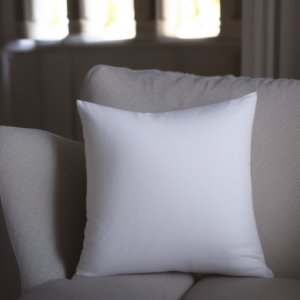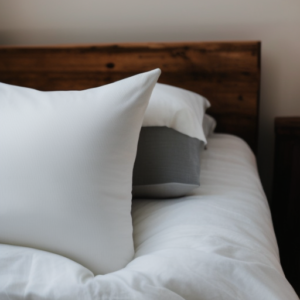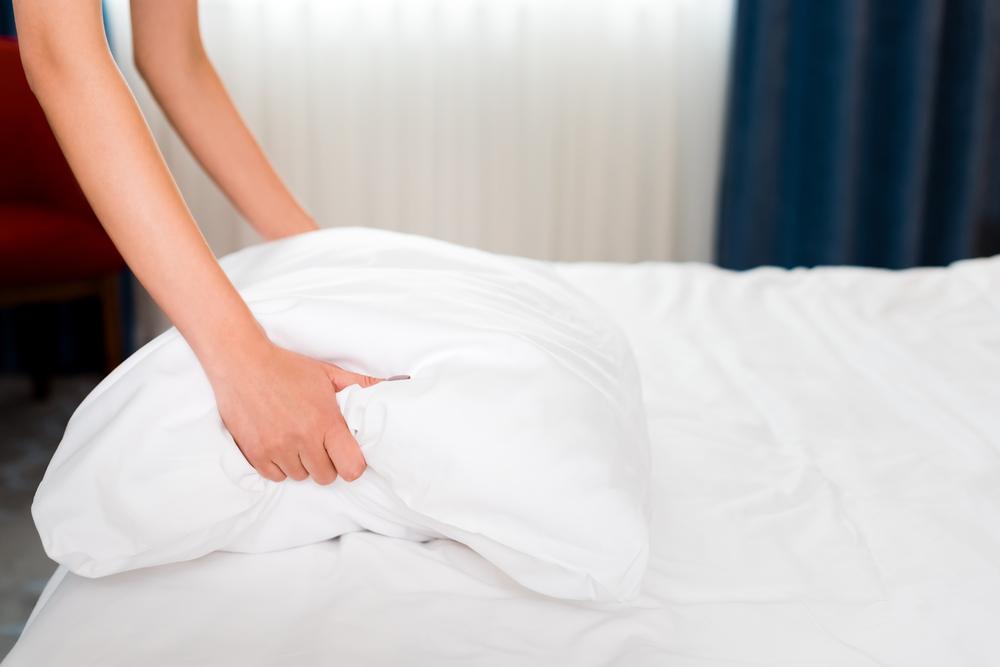Last Updated on February 19, 2023
Are you tired of waking up with a stuffy nose and itchy eyes? Do anti allergy pillows work to help reduce your allergies, or is this just another marketing ploy? We’ve all heard the promises from product manufacturers that their products can do wonders for our health. But when it comes to something as important as fighting allergies, we need real answers. In this blog post, we’ll explore what anti-allergy pillows are, how they work and if they really make a difference in reducing symptoms – so you can decide whether these special pillows will be worth investing in. Let’s dive into “how do anti allergy pillows work” once more – let’s find out.
Table of Contents:
- What are Anti Allergy Pillows?
- Benefits of Anti Allergy Pillows
- How Do Anti Allergy Pillows Work?
- Are Anti Allergy Pillows Effective?
- Conclusion
What are Anti Allergy Pillows?
Anti allergy pillows are specially designed to help reduce the symptoms of allergies. They are made from materials that are hypoallergenic and resistant to dust mites, mould, mildew, and other allergens. Unlike regular pillows, which can be made from a variety of materials such as cotton or polyester, anti allergy pillows use special fabrics like bamboo rayon or microfiber that have been treated with an anti-allergy coating. This coating helps prevent dust mites and other allergens from settling in the pillow material and causing irritation for those who suffer from allergies.
The fabric used in these pillows is also breathable, so it allows air to circulate through it more easily than traditional fabrics like cotton or polyester. This helps keep your head cool while you sleep since heat can make allergies worse. The filling inside the pillow is usually synthetic fibres such as memory foam or gel-infused foam which provide extra support for your neck and head while sleeping without trapping heat against your skin like some natural fillings do.
The use of an anti allergy pillow also provides the advantage of having a removable cover, making it easier to clean than traditional pillows. This is because you don’t have to worry about washing the entire item each time you want to freshen up its look or eliminate any potential allergens that may have settled into it over time; simply take off the cover and put it in the wash.
Anti allergy pillows are a great way to reduce the risk of allergies and provide a more comfortable sleeping experience. However, it is important to do your research and make sure you choose the right one for your needs in order to get the most out of them – let’s take a look at some of their benefits now.
Benefits of Anti Allergy Pillows
When it comes to improving the quality of your sleep, anti-allergy pillows can be a great help. Allergens such as dust mites, pet dander and pollen can cause allergic reactions that make it difficult to get comfortable and restful sleep. Anti-allergy pillows are designed to reduce exposure to these allergens by providing a barrier between you and them.
The most common type of anti-allergy pillow is made from synthetic materials such as polyester or microfiber, which helps prevent dust mite allergies. These fabrics are tightly woven, so they don’t allow any air through, trapping the allergens inside the pillow instead of allowing them into your lungs when you breathe in during the night. This makes them ideal for people who suffer from asthma or other respiratory conditions caused by airborne allergens.

Another benefit of using an anti-allergy pillow is that they are hypoallergenic, meaning they won’t trigger any allergic reactions themselves, even if you have sensitive skin or allergies to certain fabrics like wool or down feathers. They also tend to be more durable than regular pillows since their material is designed specifically for this purpose and will last longer without losing its shape over time due to constant use.
Anti allergy pillows also provide better support than traditional ones because their construction allows for more cushioning around your head and neck while still being firm enough not to flatten out after extended use like some feather filled options do. This helps keep your spine aligned properly throughout the night, which reduces pain in those areas when you wake up in the morning and improves overall comfort levels while sleeping too.
Finally, having an anti allergy pillow means less sneezing fits during nighttime hours since there aren’t any loose dust particles floating around that could irritate your nose while trying to rest peacefully. It may take some trial and error before finding one with just the right amount of fluffiness, but once found, these types of pillows offer many benefits, including improved breathing ability, fewer allergic reactions, and better posture alignment, leading toward healthier nights spent snoozing away.
By investing in an anti allergy pillow, you can enjoy a comfortable and peaceful night’s sleep while reducing the risk of allergies or skin irritation – but how do these pillows actually work? Let’s take a look.
How Do Anti Allergy Pillows Work?
Anti-allergy pillows are designed to provide a barrier against dust mites and other allergens. They are made from special materials that trap the allergens in their fibres, preventing them from entering your airways. The most common type of anti-allergy pillow is filled with synthetic fibres such as polyester or microfiber. These fabrics are tightly woven together, creating an effective barrier between you and any potential allergens.
The fabric used for these pillows also helps to reduce moisture build up which can lead to mould growth. This is especially important if you suffer from allergies caused by mould spores or pet dander. Additionally, many anti-allergy pillows come with a hypoallergenic cover which further reduces the risk of exposure to allergens while sleeping.
Another way anti allergy pillows work is through the use of antimicrobial treatments applied during the manufacturing process. These treatments help prevent bacteria and fungi from growing on the surface of the pillow, reducing your chances of developing an allergic reaction when using it at night time. Some manufacturers even offer additional protection by adding silver ions into their products which have been proven to be highly effective against bacteria and fungi growths on textiles such as bedding items like sheets and blankets too.
Finally, some manufacturers may also incorporate special chemical compounds known as “anti-dust mite” agents into their products to provide additional protection from dust mite related allergies. These chemicals are designed to disrupt the growth and spread of dust mites in order to reduce the risk of exposure during sleep. Additionally, these anti-allergy pillows can be further enhanced with silver ions which have been proven effective against bacteria and fungi on textiles such as bedding items like sheets and blankets.
Overall, anti allergy pillows are designed specifically for those who suffer from allergies caused by dust mites or other airborne particles while they sleep at night time. These pillows provide a safe haven where people can rest easy knowing that no harm will come upon them due to contact with these potentially dangerous substances.
From the effectiveness of anti allergy pillows to the range of materials they are made from, there is a lot to consider when it comes to understanding how these pillows work. But now that we’ve explored this topic in depth, let’s take a closer look at whether or not these pillows actually make a difference in providing relief from allergies.
Are Anti Allergy Pillows Effective?

This is a question many people with allergies and asthma have. The answer is yes, they can be very helpful in reducing symptoms of allergies and asthma as well as improving sleep quality.
Anti allergy pillows are specially designed to reduce the amount of allergens that enter your body while you sleep. They are made from materials such as hypoallergenic polyester or cotton, which prevents dust mites, pet dander, pollen, mould spores, and other common allergens from entering your lungs while you rest. Additionally, these pillows come with a special cover that helps keep out additional allergens like dust mites and pet dander.
The effectiveness of anti allergy pillows depends on how well they fit into your sleeping environment. For example, if you use an old pillowcase or sheets that contain dust mites or other allergens, then the pillow won’t be able to do its job properly. It’s important to make sure all bedding items are regularly washed in hot water (at least 130°F), so any potential allergens are eliminated before using an anti-allergy pillow.
Finally, most experts agree that regular maintenance is key when it comes to keeping your anti-allergy pillow clean and free from potential irritants: washing covers every two weeks (or more often if needed), replacing inner fillings every 6 months (or sooner if necessary), airing out the entire item at least once per month, etc., will help ensure maximum efficiency over time.
Overall, anti-allergy pillows can be highly effective in reducing symptoms associated with allergies and asthma as well as improving overall sleep quality – but only when used correctly according to manufacturer instructions. Therefore, it is important to read up on how best to use yours before investing in one; this could make all the difference between a good night’s restful slumber…and another sleepless night spent sneezing away.
Conclusion
In conclusion, anti allergy pillows are a great way to reduce the amount of allergens in your home. They work by trapping dust mites and other allergens in their special material, making them less likely to cause an allergic reaction. So do anti allergy pillows work? Yes. With proper care and maintenance, they can be very effective at reducing allergies and providing you with a more comfortable sleep experience.
Paul is the type of person who never met a problem he couldn’t fix. He can always be found tinkering with something in his house, even if it isn’t broken! His tips and tricks are often shared on our site. He’s the one you call when something breaks because he has been known to improvise fixes for everything from leaky faucets to malfunctioning dryers.

